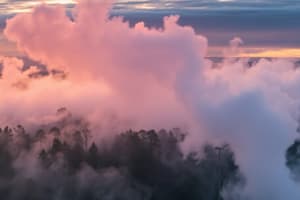Podcast
Questions and Answers
Explain how air pollution is defined, including the types of substances involved and their effects.
Explain how air pollution is defined, including the types of substances involved and their effects.
Air pollution is the introduction of chemicals, particulate matter, or microorganisms into the atmosphere at concentrations high enough to harm plants, animals, and materials, or to alter ecosystems.
Volcanoes and lightning are examples of what kind of pollution?
Volcanoes and lightning are examples of what kind of pollution?
Natural Emission
Describe the difference between the effects of pollutants with short residence times versus those with long residence times in the atmosphere.
Describe the difference between the effects of pollutants with short residence times versus those with long residence times in the atmosphere.
Pollutants with short residence times exert localized impacts, while those with long residence times have regional or global impacts.
What criteria pollutants are a result of burning any kind of incomplete combustion?
What criteria pollutants are a result of burning any kind of incomplete combustion?
Explain why tropospheric ozone is considered a pollutant, while stratospheric ozone is not.
Explain why tropospheric ozone is considered a pollutant, while stratospheric ozone is not.
What criteria pollutant is a corrosive gas that comes primarily from combustion of fuels?
What criteria pollutant is a corrosive gas that comes primarily from combustion of fuels?
What is a volatile organic compound (VOC)? Give an example of a VOC.
What is a volatile organic compound (VOC)? Give an example of a VOC.
What is the primary anthropogenic source of nitrogen oxides?
What is the primary anthropogenic source of nitrogen oxides?
How do heat and sunlight contribute to ozone creation?
How do heat and sunlight contribute to ozone creation?
A student is trying to remember the names of 6 criteria pollutants. What are they?
A student is trying to remember the names of 6 criteria pollutants. What are they?
What is true of carbon dioxide, in relation to the other criteria pollutants?
What is true of carbon dioxide, in relation to the other criteria pollutants?
How does particulate matter affect the atmosphere and visibility?
How does particulate matter affect the atmosphere and visibility?
What causes nitrogen oxides?
What causes nitrogen oxides?
List three sources of VOCs.
List three sources of VOCs.
How does lead affect human health, particularly concerning the nervous system?
How does lead affect human health, particularly concerning the nervous system?
Name two natural events that can cause air pollution.
Name two natural events that can cause air pollution.
What distinguishes PM2.5 from PM10 in terms of particle size and potential health impacts?
What distinguishes PM2.5 from PM10 in terms of particle size and potential health impacts?
Explain the role of nitrogen oxides ($\text{NO}_x$) as a precursor in the formation of photochemical smog.
Explain the role of nitrogen oxides ($\text{NO}_x$) as a precursor in the formation of photochemical smog.
Discuss the environmental impacts of sulfur dioxide ($ ext{SO}_2$) emissions, particularly in relation to acid rain.
Discuss the environmental impacts of sulfur dioxide ($ ext{SO}_2$) emissions, particularly in relation to acid rain.
Even though Carbon Dioxide isn't a criteria pollutant, why is it being discussed in Air Pollution?
Even though Carbon Dioxide isn't a criteria pollutant, why is it being discussed in Air Pollution?
Flashcards
What is air pollution?
What is air pollution?
Introduction of chemicals, particulate matter, or microorganisms into the atmosphere at high concentrations, harming plants, animals, and ecosystems.
What are Natural emissions of pollution?
What are Natural emissions of pollution?
Volcanoes, lightning, forest fires, and living or dead plants releasing compounds.
What are Anthropogenic sources of pollution?
What are Anthropogenic sources of pollution?
On-road vehicles, power plants, industrial processes, and waste disposal (incinerators).
What is residence time?
What is residence time?
Signup and view all the flashcards
What are criteria pollutants?
What are criteria pollutants?
Signup and view all the flashcards
Name the six criteria pollutants.
Name the six criteria pollutants.
Signup and view all the flashcards
What is Carbon Monoxide (CO)?
What is Carbon Monoxide (CO)?
Signup and view all the flashcards
What is Sulfur Dioxide (SO₂)?
What is Sulfur Dioxide (SO₂)?
Signup and view all the flashcards
What are Nitrogen Oxides (NOx)?
What are Nitrogen Oxides (NOx)?
Signup and view all the flashcards
What is Ozone (O3)?
What is Ozone (O3)?
Signup and view all the flashcards
What is Particulate Matter (PM)?
What is Particulate Matter (PM)?
Signup and view all the flashcards
What is Lead (Pb)?
What is Lead (Pb)?
Signup and view all the flashcards
What is Volatile Organic Compound (VOC)?
What is Volatile Organic Compound (VOC)?
Signup and view all the flashcards
Study Notes
- EQ: The student will be able to identify and describe the six criteria pollutants.
- Unit 6 Tests are graded, grades were updated in PowerSchool.
- Fish are here and will be placed in Ecocolumns.
- Unit 7 Calendar.
- Scrapesbook is due by April 11th at 11:59 p.m.
- Unit 7 Atmospheric Pollution includes Chapter 12 Module 35, Chapter 14 Module 44, Chapter 15 Module 46, 47, 48, 49 and 50.
7.1 Introduction to Air Pollution
- Air pollution: The introduction of chemicals, particulate matter, or microorganisms into the atmosphere at concentrations high enough to harm plants, animals, and materials such as buildings, or to alter ecosystems.
- Natural emissions of pollution include volcanoes, lightning, forest fires, and plants, both living and dead.
- Anthropogenic sources include on-road vehicles, power plants, and industrial processes.
- Residence time: The time a pollutant stays in the atmosphere.
- Pollutants with brief residence times exert localized impacts over short time periods, such as particulate matter and automobile exhaust.
- Pollutants with long residence times exert regional or global impacts, such as pollutants causing climate change or ozone depletion.
- The EPA sets nationwide standards for emissions and concentrations of toxic pollutants.
- States monitor air quality.
- The EPA takes over enforcement if plans are inadequate.
- Criteria pollutants: Pollutants that pose especially great threats to human health, which include carbon monoxide, sulfur dioxide, nitrogen dioxide, tropospheric ozone, particulate matter, and lead.
- Carbon Monoxide (CO): A common emission in vehicle exhaust and a significant component of air pollution in urban areas.
- It is a problem in developing countries where people may cook with manure, charcoal, or kerosene indoors and results from incomplete combustion.
- Sulfur dioxide (SO₂): A corrosive gas from combustion of fuels, such as coal, oil, and gasoline.
- It is a respiratory irritant that can adversely affect plant tissue and is released during volcanic eruptions and forest fires.
- Nitrogen Oxides (NOx): Motor vehicles and stationary fossil fuel combustion are the primary anthropogenic sources.
- Respiratory irritant, increases susceptibility to respiratory infection.
- An ozone precursor, leads to formation of photochemical smog.
- Converts to nitric acid in atmosphere, which is harmful to aquatic life and some vegetation.
- Contributes to over-fertilizing terrestrial and aquatic systems.
- Ozone (O3): A secondary pollutant formed when heat and sunlight cause chemical reactions between oxides of nitrogen (NOx) and Volatile Organic Compounds (VOCs), also known as Hydrocarbons.
- Reaction can occur both near the ground and high in the atmosphere.
- Tropospheric ozone is bad ozone, while stratospheric ozone is good ozone.
- Ozone has a sweet smell.
7.1 Introduction to Air Pollution and 7.4
- Particulate matter (PM): Solid or liquid particles suspended in air.
- PM2.5: Diameter less than 2.5 micrometers (fine particles).
- PM10: Diameter less than 10 micrometers.
- Sources of particulate matter include burning coal, oil, diesel, biofuels, agriculture, and road construction.
- Lead (Pb): A gasoline additive, also found in oil, coal, and old paint.
- It impairs the central nervous system and can have measurable effects on learning and ability to concentrate.
- Other emissions include carbon dioxide (CO2) released by burning fossil fuels, which has led to it becoming a major concern.
- CO2 recently exceeded a concentration of 400 parts per million in the atmosphere and appears to be steadily increasing each year.
- Appears naturally from respiration, decomposition and volcanic eruptions.
- Not a criteria pollutant.
- Is a greenhouse gas and does lead to Earth's warming.
- Volatile organic compound (VOC): An organic compound that evaporates or sublimates at room temperatures.
- Formed by evaporation of fuels, solvents, paints, and improper combustion of fuels such as gasoline.
- A precursor to ozone formation.
- Examples include formaldehyde and gasoline.
- Trees are a natural source of VOCs.
Studying That Suits You
Use AI to generate personalized quizzes and flashcards to suit your learning preferences.




